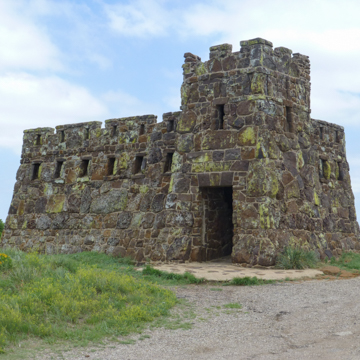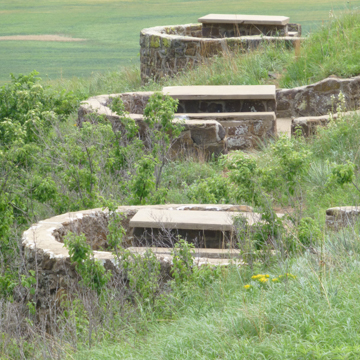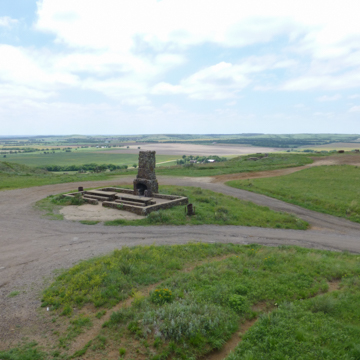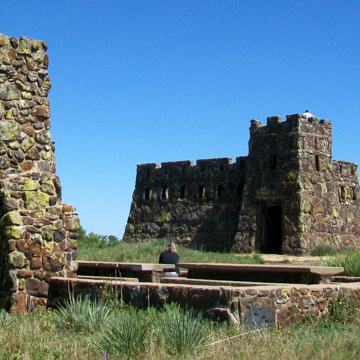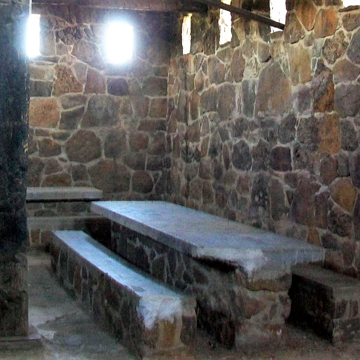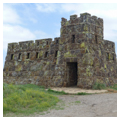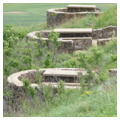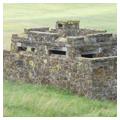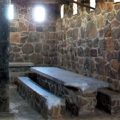Coronado Heights is a unique 16.8-acre public recreational area located atop a sandstone butte in the midst of a broad valley in southern Saline County, 18 miles south of Salina and 3 miles north of Lindsborg. It serves as a memorial to Francisco Vasquez de Coronado, who purportedly led a group of Spaniards to the area in the middle of the fifteenth century in pursuit of gold. A commanding location, it is understandable why early explorers would have been drawn to this vantage point. From the top of the butte one can see across the valley and to the horizon in all directions. The site was developed through the assistance of the Works Progress Administration (WPA).
The sandstone butte, which came to be known as Coronado Heights, rises 300 feet above the Smoky Hill Valley below. The legends that grew in the region around Coronado’s alleged presence in the area were fueled by a 2-inch-square piece of chain mail that was found in 1915 by a student of Johan August Udden, a professor at Bethany College, who speculated that this small artifact provided clear evidence of Coronado’s presence in the area. Later scholars were able to conclude with some certainty that the Smoky Hill Valley was indeed the place that Coronado described as Quivira, the destination of his journey.
In 1919, recognizing the scenic potential of the majestic butte and the panoramic view, the Smoky Hill Historical Society purchased the land. To attract automobile travelers, the Society began construction on a roadway to the top of the butte, where they also began building a wood-frame structure named Fernebo Lodge. The site opened as Coronado Heights in 1921 but access remained problematic and funding dried up during the Great Depression. After the founding of the WPA in 1935, leaders from Saline County and Lindsborg in McPherson County applied for funding to complete the work that had been begun on Coronado Heights. Saline County acquired the property and secured the federal grant.
WPA workers built a more substantial road to the top of the butte as well as a large gathering area with a giant fireplace on the spot where the incomplete Fernbo Lodge had stood. They also built a lodge that evokes a historic Spanish fort, with a meeting room on the bottom and an observation deck on top. A rudimentary rest room facility for men and women was also erected, and 15 family-sized picnic areas, each furnished with a table and a fireplace, were carved into the edges of the butte. All of the structures feature locally quarried sandstone with concrete roof slabs. Built in the Rustic style, the rock was all laid in random, uncoursed patterns. The construction involved the kind of labor-intensive work that the WPA sought to promote.
In 1941 the 300th anniversary of Francisco Vasquez de Coronado’s trek to Kansas was celebrated with a number of events held on Coronado Heights. These events solidified the myth of the early Spanish explorers standing atop the butte surveying the verdant landscape below. In 1988 the Smoky Valley Historical Association, the successor to the Smoky Valley Historical Society, acquired the site and again sought to promote tourism to this distinctive place. Since the Dakota sandstone used in the site improvements is quite soft, through the years water has eroded some elements, visitors have carved their names or initials into some walls, the stone has aged and taken on different colors, and lichen has grown on the building forms, giving them an irregular greenish tint. It is easy to imagine Coronado Heights to be a ruin far older than its actual age.
References
Davis, Christy, “Coronado Heights,” Saline County, Kansas. National Register of Historic Places Inventory-Nomination Form, 2010. National Park Service, U.S. Department of the Interior, Washington, D.C.
Rosen, Elizabeth, Jon Taylor, and Kathy Ambler, “New Deal-Era Resources of Kansas.” National Register of Historic Places Multiple Property Documentation Form, 2002. National Park Service, U.S. Department of the Interior, Washington, D.C.





